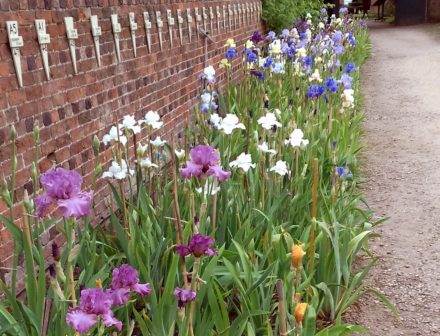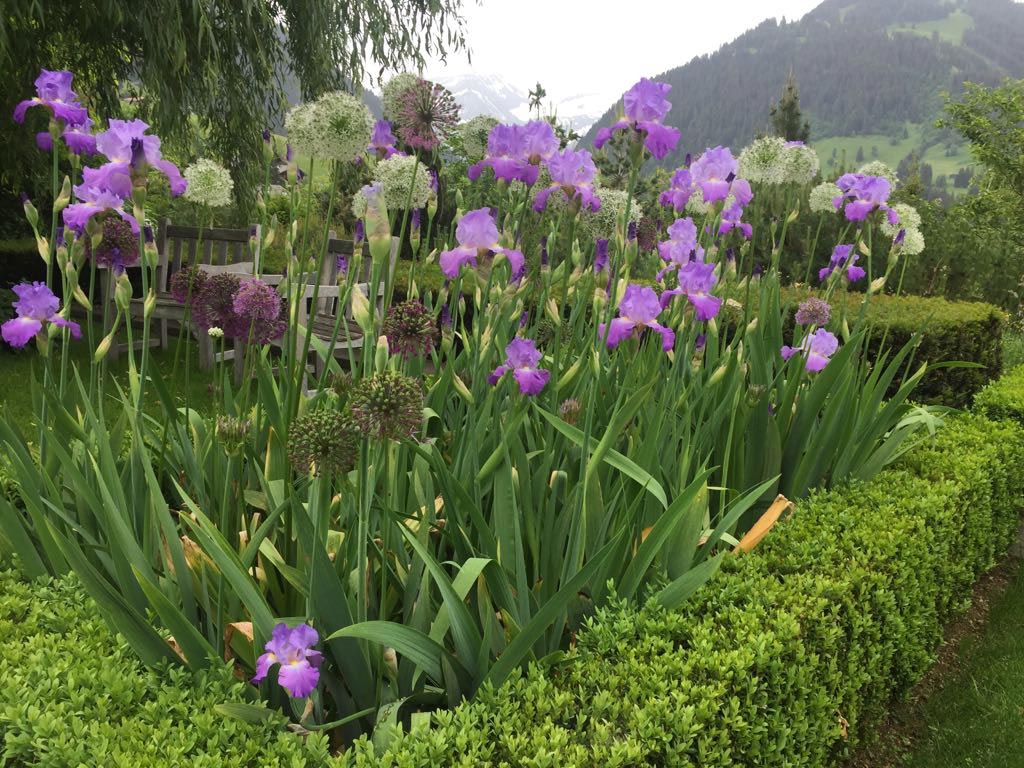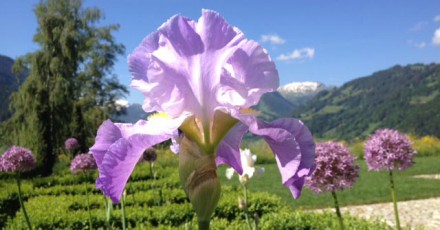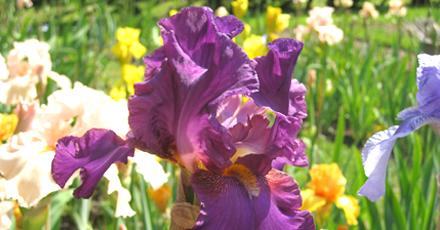Companion Planting with Bearded Irises
Optimal Growing Conditions
Companion Planting with Bearded Irises is easier than you think. But, first you need to understand the basics. Bearded Irises do best in a south facing bed, so choose the hottest place in your garden, and you won't go far wrong. Plant them in soil that is free draining and PH neutral.
This allows the sun to bakes the rhizomes that produce the flower cells for the following year. After finding your sunny spot, good drainage is the next thing on your list. This is needed to prevent the root system becoming waterlogged, and vital to stop rhizome rot, the commonest reason for plant failure.
Our Bearded Irises work really well as Companion Plants. They are all bred and grown in the UK. They are well-suited to UK weather conditions, remarkably tough, long-lived and bulk up well. If you get the basics right, they will last for years and years.
The Choice
You need to decide whether to plant Bearded Irises as part of a dedicated iris border, or include them with Companion Plants in a more general planting plan. This is the dilemma facing gardeners and garden designers alike.
If you have plenty of space, go for a dedicated iris bed. If space is more limited, irises can be planted successfully with other herbaceous Companion Plants.
The Dedicated Iris Bed
One good way of growing Bearded Irises is to plant them alongside a south-facing garden wall. However, there are other alternatives. Try planting them within a box hedge compartment, as on the parterre at Doddington near Lincoln.

Concept of Companion Planting
This is used traditionally to describe a way of planting a mix of different varieties, often vegetables, to protect plants from pests and diseases. However, the term ‘Companion Planting’ today is more commonly applied to the process of mixing different plants in a planting scheme to create impact, provide contrast, extend the flowering season, or combinations of each.
Why our Bearded Irises make Ideal Companion Plants
Bearded Irises flower during the difficult lean period in the garden year that spans the transition from Spring to Summer. In addition, they come with a wide colour range. So, this makes them well-suited to fit different planting schemes, working just as well in either a Spring or Summer border. As a result, this versatility means they are particularly useful Companion Plants when used with other plants.
A further important feature of our Bearded Irises is their clear clean colours, allowing you to create your own colour palette. We group our irises on the website into ‘Cool’, ‘Soft’ and ‘Hot’ colours and show how these can be combined to create style and structure in your garden.
Our Bearded Irises really do make ideal Companion Plants.
Are there any problems with companion planting?
As we can see, using Bearded Irises as Companion Plants with other plant varieties has many benefits. However, there is one serious drawback and you need to be aware of this from the outset. It is vital that your iris rhizomes do not become shaded or, worst still, covered by other plants during the summer.
Why is this so important? If the rhizomes are covered, the chances of their flowering successfully the following year are much reduced. This becomes more of an issue once the Irises have flowered, as Summer gathers pace and your other herbaceous plants become increasingly vigorous.
Under these circumstances it is only too easy after flowering to forget about your irises. You enjoy the profusion of a Summer border, only to realise too late the following year when your Bearded Irises fail to flower.
Characteristics of Good Companion Plants
There are a few general rules that are worth considering when choosing the best Companion Plants for Bearded Irises.
(i)Your irises need a sunny aspect, so try using varieties that tolerate similar conditions.
(ii) Choose plants that do not produce an abundance of foliage that will shade the iris rhizomes, over those that have vigorous leaf growth.
Alliums are a good example of a plant that meets both criteria, and one of my favourites. However, your final choice of companion plant will be governed by the overall effect you wish to achieve.
Companion Planting for Effect
Companion Planting using Bearded Irises can be used in different ways.
(i) Contrast/Impact
Bearded Irises are plants with real impact in their own right, but you can mix them with other plants that have similar characteristics, and which flower at the same time. Try combining Our Bearded Irises with Herbaceous and Tree Peonies to create something truly stunning?
This is where our Irises with their clear clean colours come into their own. If you want softer pastel shades, try mixing ‘Whites’ (Darley Dale and Jessica Rosalind), with ‘Pinks’ (Catherine Seville/Sherwood Pink) or with ‘Yellows’ (Lime Soda). Plant these with peonies (Whites/pale pinks and citron yellow). There are so many different peony varieties to choose from.
If you want stronger colours, we have a great choice. Use hot ‘Reds’ (Red Pike and Red Kite), ‘Oranges’ (William of Orange and Old Hall), ‘Yellows’ (Charnwood Delight) and ‘Magenta’ (Blaeberry Pie) with the Pinks (Catherine Seville/Sherwood Pink). Plant these with peonies (Reds, Pinks) for real impact.
(ii) Texture
Use our Bearded Irises as Companion Plants with other plants that have different habits. Try choosing different flower shape and leaf forms to provide the desired contrast in texture you seek. Also, by selecting varieties carefully by colour, you can achieve a colour mix that will show off the texture of the Companion Plant to best effect.
And here our clear colours come to your aid. Try planting a mix of our Irises, ‘Cool’ colours (whites and blues) with ‘Softs’ (pinks and pale yellows), as shown above. You can do the same with the ‘Hot’ colours, as described above.
Good examples of Companion Plants are Poppies (Oriental and Welsh), Columbines, Daisies.
(iii) Height
Tall Bearded Irises add Height and structure to any border.
Plant them in different places, with either other Tall plants (Alliums, Delphiniums, Lupins, Foxgloves, Phlox). Use them with other smaller plants in front (Columbines, Dianthus, Cranesbill, Violas, Tulips, Lavender (dwarf varieties), or a combination of the two.
(iv) Extend the Flowering Season
Bearded Irises flower during May and June. By choosing carefully a mix of our ‘Early’, ‘Mid’ and ‘Late’ flowering varieties, you can achieve six weeks of bloom.
Planning your Border
Your Bearded Irises can be planted in either a Spring or Summer border. In a Spring planting scheme, they provide the stunning finale. They are preceded by Camassia, Tulips, Narcissus (late flowering varieties), Hellebores, Daffodils and Crocus.
In a Summer border Bearded Irises are the star opening act, they provide a ‘blast’ of colour that heralds the start of Summer. They flower at the same time as the first of the species roses. However, they are followed by a succession of other plants that will provide interest through the summer until the Autumn.
This can include the following (Peonies, Lupins, Roses, Poppies, Delphiniums, Foxgloves, Monkshood, Black eyed Susan, Cranesbill, Salvias, Rudbeckia, Coral Bells)
Why not try mixing our Bearded Irises with Alliums within a box compartment, as seen below, and create something really stylish? Be confident that it will provide interest before and long after the irises have flowered, with the spear-shaped leaves complemented by the drying spikes of the Alliums lasting well into Autumn.

Bearded Irises in Dry Borders
Any planting scheme is easy to manage if you choose Companion Plants that like the same hot dry conditions as your irises. The key is to ensure succession flowering throughout the Summer.
Alliums work well in many settings with Bearded Irises, and are one of my favourites. They love the dry conditions, and most produce relatively little leaf growth, with the flower spikes drying beautifully as the season progresses. Choose a mix of early varieties that bloom before your irises, some that flower at the same time, and others that flower later.
Grasses are a good choice and will flower throughout the season and on into the Autumn. Choose varieties that are not too vigorous for best results. Day Lillies (Hemerocallis) with their wide colour range, will provide the colour and impact after the irises have stopped flowering. Geums will flower throughout the Summer, and if dead-headed, will produce more flowers at the back end. There is plenty of choice. Use compact forms where possible to prevent shading.
Experiment with other varieties: Euphorbia(Wulfennii), Knautica Macedonica (June-September), Teasels (Fullonum)/June- August), Eremurus (Flower June-July), Perovskia (compact form), Lavender(Little Lottie/Lady Ann), Cat Mint (Little Titch/Snowflake), Agapanthus (Silver baby), Artemisia (Powys castle) Gaura, Sea Hollies, Verbascum (Chantilly), Sedums, Gallardia, Lychnis Coronaria (Gardeners World), Echinacea, Rudbeckia, Phlox, Nerines, Stipa (tenuissima).
Frequently Asked Questions
What Are the Best Conditions for growing Bearded Irises?
- South Facing (find the hottest place in your garden)
- Soil type - Free Draining and PH Neutral.
Why Our Bearded Irises Make Ideal Companion Plants?
- Flowering Period - They fill an awkward gap in the garden year, between the last of the Spring Bulbs and the start of an exuberant Summer Border.
- Clear Clean Colours - Create your own colour palette and use our Award Winning Bearded Irises in different planting schemes. Mix our 'Cool/Soft Colours' with your pastel shades, or experiment with our 'Hot/Soft Colours' for impact.
- Versatility - plant our irises in a Spring or Summer Border.
Are there any Problems of Growing Bearded Irises with other Companion Plants?
Planting Position - Iris Rhizomes need to bake to produce flower cells for the following year. So, it is important to make sure that your rhizomes are not shaded by other plants. You also need to think carefully about where you plant your irises and try to give them space. And, one more thing, choose Companion Plants carefully that do not produce a lot of leaf growth at ground level. Alliums work really well.
What type of Border is most suitable for growing Bearded Irises with other Companion Plants?
- Spring Border - Plant Bearded Irises to provide a stunning finale in your Spring Border, preceded by Camassia's, late flowering Tulips and Narcissae, Hellebores and Spring Bulbs.
- Summer Border - Bearded Irises are the star opening act, but followed by other plants that will ensure continuous flowering well on into the Autumn. (Alliums, Peonies, Hemerocallis, Delphiniums, Lupins, Rudbeckia, Hellenniums, Coral Bells).
What are the best Companion Plants for Bearded Irises in a Dry Border?
- Alliums (Choose a mix of early-late flowering varieties)
- Hemerocallis - useful to provide impact after the irises have finished flowering
- Grasses - Use non- invasive varieties (Stipa Tenuissima)
- Lavenders/Perovskia/Cat Mint - dwarf varieties
- Agapanthus/Nerines
Summary
Our Bearded Irises make ideal Companion Plants. They should be a key part of any garden planting scheme. Use them in a Dedicated Iris Bed if you have the space, along a wall, or in a more formal setting with box. Plant them to great effect in either a Spring or Summer Border, alternatively, develop them as a feature in your Dry Garden.
Create your own colour palette with our clear clean colours and choose Companion Plants to suit. Use them with different planting schemes with ‘Cools’ (whites and blues) / ‘Softs’ (pink/pale yellow), or strong ‘Hots’ (Oranges/Yellows/Reds/Mulberry) mixed with ‘Softs’ (pinks/apricots/pale yellows). Our Bearded Irises are such versatile plants.
Simon Dodsworth
March 2021












